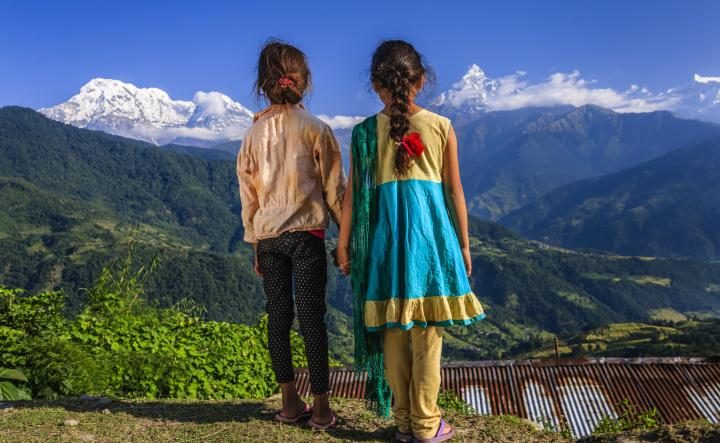World’s Highest Peaks, Hit hard by Climate Change; the Impacts Are Cascading Down to Some of Earth’s Most Densely Populated Areas
28 October 2019 (World Meteorological Organization) The world’s highest peaks, ranging from the Andes to the Alps and the Third Pole to the tropics, are being hit hard by climate change, and the impacts of this are cascading down to some of Earth’s most densely populated areas. The rapidly melting mountain glaciers serve as a source of freshwater for major rivers. Those rivers are vital for humans, ecosystems, agriculture, industry and serve as a means of transportation.
Weather forecasts, climate and water management services are often inadequate, and hazards such as glacial outflows and landslides regularly destroy lives and livelihoods.
The World Meteorological Organization and a wide array of partners are therefore convening a High Mountain Summit on 29–31 October. It will bring together more than 150 stakeholders from all over the globe to identify priority actions to support more sustainable development, disaster risk reduction and climate change adaptation both in high-mountain areas and downstream. This includes a roadmap to improve hydrometeorological services to address water and hazard impacts and management.
Mountain regions cover about a quarter of the Earth’s land surface and are home to around 1.1 billion people. They are often known as the “water towers of the world” because river basins with headwaters in the mountains supply freshwater to over half of humanity, including in the mountainous Himalaya-Hindu Kush and Tibetan Plateau region, known as the Third Pole.
The mountain cryosphere – glaciers, snow, and permafrost – are increasingly vulnerable to the effects of constantly rising global temperatures, threatening food security, freshwater supply and river transportation. Iconic peaks such as Mount Everest, Mont Blanc, Kilimanjaro and the Rocky Mountains are all impacted.
“Accelerating glacier retreat and receding ice and snow cover is perhaps the most visible sign of climate change. There has been a boost in the melting of 31 major glaciers, especially during the past two decades,” said WMO Secretary-General Petteri Taalas.
“Precipitation distribution is changing, as is the amount and seasonality of runoff in snow-dominated and glacier-fed river basins. In the short term, this may mean an increase in hazards, whilst in the long-term it is expected to lead to increasing water stress and negative impacts on agriculture, food security and energy supplies,” he said.
“Science-based hydro-meteorological observations, information and services are key to climate resilience and adaptation and to inform policy-making on the allocation and use of resources, regarding water security and risk management, at national, local, and community level,” said Mr Taalas, who will speak at the opening session of the three-day conference.
The high–level opening session features an address by Swiss Federal Councillor and Interior Minister Alain Berset. Switzerland is witnessing dramatic glacier retreat and threats to its vital winter tourism as a result of rising temperatures.
A concluding high-level segment will adopt a Call for Action.
The High Mountain Summit follows shortly after the release of the Intergovernmental Panel on Climate Change (IPCC) Special Report on the Ocean and Cryosphere in a Changing Climate, which includes a dedicated chapter on high mountain areas.
The IPCC report said that current trends in cryosphere-related changes in high-mountain ecosystems are expected to continue and impacts to intensify. Snow cover, glaciers and permafrost are projected to continue to decline in almost all regions throughout the 21st century.
Mountain Research Initiative Executive Director Carolina Adler, a lead author of the IPCC report chapter on the changes occurring in high mountain areas, is co-chair of the High Mountain Summit. John Pomeroy, Canada Research Chair in Water Resources & Climate Change; Director, Centre for Hydrology of University of Saskatchewan, and Director, Global Water Futures Initiative, Canada., is the other co-chair.
Thematic sessions will focus on:
- Drivers for Action
- Stakeholders and needs
- Closing the capacity gap
- Enhancing observations and access to data
- Research and innovation
The summit will seek to:
- Promote an integrated cross-sectoral approach on priority action and investments addressing impacts of climate change in high mountains.
- Identify practical steps for improving the provision of hydrological, meteorological, climate and prediction services to optimize and cryosphere and high mountain observations and access to data, and advance scientific research.
- Identify roadmaps for climate risk and early warning systems for mountain-specific and transboundary threats, including extreme events, glacial lake outburst floods, avalanches, permafrost thawing related risks, Foehn type wind storms, air pollution, and others.
- Promote closer and interactive links between science and policy at all levels of governance, ensuring science-based input to policy development and long-term adaptation strategies.
Sponsors of the High Mountain Summit include the World Bank Global Facility for Disaster Reduction and Recovery and Swiss government agencies. It is co-organized by:
- Food and Agriculture Organization
- Global Water Futures
- International Association of Cryospheric Sciences
- International Centre for Integrated Mountain Development
- International Network for Alpine Research Catchment Hydrology
- Mountain Partnership (FAO)
- Mountain Research Initiative
- Third Pole Environment
- UNESCO International Hydrological Programme
- World Bank Global Facility for Disaster Reduction and Recovery
- World Bank Central Asia Water and Energy Program






